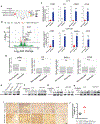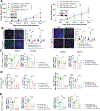Targeting NTRK1 Enhances Immune Checkpoint Inhibitor Efficacy in NTRK1 Wild-Type Non-Small Cell Lung Cancer
- PMID: 39250241
- PMCID: PMC11611666
- DOI: 10.1158/0008-5472.CAN-24-0658
Targeting NTRK1 Enhances Immune Checkpoint Inhibitor Efficacy in NTRK1 Wild-Type Non-Small Cell Lung Cancer
Abstract
Treatment of non-small cell lung cancer (NSCLC) has drastically changed in recent years owing to the robust anticancer effects of immune checkpoint inhibitors (ICI). However, only 20% of the patients with NSCLC benefit from ICIs, highlighting the need to uncover the mechanisms mediating resistance. By analyzing the overall survival (OS) and mutational profiles of 424 patients with NSCLC who received ICI treatments between 2015 and 2021, we determined that patients carrying a loss-of-function mutation in neurotrophic tyrosine kinase receptor 1 (NTRK1) had a prolonged OS when compared with patients with wild-type NTRK1. Notably, suppression of the NTRK1 pathway by knockdown or entrectinib treatment significantly enhanced ICI efficacy in mouse NSCLC models. Comprehensive T-cell population analyses demonstrated that stem-like CD4+ T cells and effector CD4+ and CD8+ T cells were highly enriched in anti-PD-1-treated mice bearing tumors with decreased NTRK1 signaling. RNA sequencing revealed that suppression of NTRK1 signaling in tumor cells increased complement C3 expression, which enhanced the recruitment of T cells and myeloid cells and stimulated M1-like macrophage polarization in the tumor. Together, this study demonstrates a role for NTRK1 signaling in regulating cross-talk between tumor cells and immune cells in the tumor microenvironment and provides a potential therapeutic approach to overcome immunotherapy resistance in patients with NSCLC with NTRK1 wild-type. Significance: Inhibition of NTRK1 signaling confers sensitivity to immunotherapy by enhancing complement C3-mediated T-cell and macrophage functions, leading to improved responses to immune checkpoint inhibitors in patients with lung cancer with NTRK1 mutations.
©2024 American Association for Cancer Research.
Conflict of interest statement
Competing Interests
No authors have any particular competing interests.
Figures






References
MeSH terms
Substances
Grants and funding
LinkOut - more resources
Full Text Sources
Medical
Research Materials
Miscellaneous

